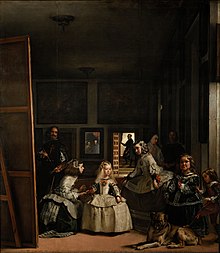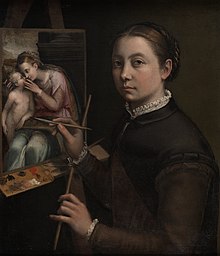Self-portraiture, or Autoportraiture is the field of art theory and history that studies the history, means of production, circulation, reception, forms, and meanings of self-portraits.[1][2][3] Emerging in Antiquity and becoming popular from the Renaissance as an artistic practice, as a specific field of study, self-portraiture is recent, but it has been expanding rapidly.

Ana Peraica wrote, about self-portraiture today, in view of the prolification of the production of self-portraits, particularly the so-called selfies:[4]
Culture of the Selfie is an in-depth art-historical overview of self-portraiture, using a set of theories from visual studies, narratology, media studies, psychotherapy, and political principles.
Self-portraiture does not only encompass the visual arts. Studies emerge from various areas, such as Philosophy.[5]Language development is dynamic and a reality. The term selfie, for example, only emerged in the 1980s. But the term, according to the Oxford English Dictionary, self-portraiture has been known since the seventeenth century.[6] Although, when we refer to self-portraiture almost simultaneously, we are remitted to artistic production, however, if we look at the contemporary literature, we will see that the universe of academic studies, mainly, is focused on several disciplines.[7]
It is possible that self-portraiture has accompanied the emergence of the individual's perception in modern society.[8]
In the visual arts, it is easy to notice the growth of artists' representations as the very theme of their creations. Dürer was the first to develop a series of works.[9] Centuries later, Rembrandt produced a great number.[10] Rare is the artist, these days, who has not been seduced by self-representation. Self-portraiture has become very common.[11]
The concepts of self-portraiture and self-portrait should not be confused. Categorization is the process by which ideas and objects are recognized, differentiated, and classified, and consists of organizing the objects of a given universe into groups or categories, with a specific purpose. It is a fundamental mechanism for reason, communication, and cognition.[12] This is, by the way, because the term "selfie" only appears in the 1980s.
History

Self-portraiture has a long history. In Reynolds & Peter's analysis, the handprints that prehistoric humanity left in cave paintings can be considered precursors of the self-portrait, as they are a direct document of the author's presence in the creative act and his perception of the existence of a "self". The self-portrait showing the artist's face or entire body appeared much later, with documented examples in Ancient Egypt and Classical Antiquity.[13]
In the Middle Ages the practice began to gain momentum, following the growing appreciation of the question of authorship in the study of artistic works, and an appreciable number of self-portraits of scribes and copyists illuminate their books and parchments, mostly anonymous, survive.[14]
Throughout the Renaissance, with the humanistic valorization of the individual, the interest in personal representation experienced an explosive growth, with particular emphasis on the author himself, both in the visual arts and in literature. According to Teresa Ferreira.[15]
The advent of new technologies today, especially since the 1980s, has had an extraordinary impact on the practice of self-portraiture. Selfies, photographic self-portraits, have become common around the world.
For a long time, self-portraits were included as small details in larger works, usually works of a religious nature, but from the Renaissance onwards they began to appear in a more striking way, to soon gain full independence in autonomous works.[16]
Attention to self-portraiture is recent in the History of Art, although there are very old collections such as that of the Uffizi Gallery, in Florence, exhibited in the Vasari Corridor, the largest pictorial collection of self-portraits.
Interests

Self-portraiture as a theoretical field attempts to answer several questions in modern times, from the most basic: what is a self-portrait? Or, why over the centuries has the number and quantity of works dedicated to it grown? Or why selfies have become a global phenomenon? It is also the object of his interest to analyze the relationship between self-representation and reality, since self-portraits often do not aim at the mere faithful reproduction of objectively identifiable traits, but, being intentional constructions, they can be allegorical, idealizing, critical, symbolic, psychological, satirical, philosophical, reflective.[17]
The self-portrature as an academic study only emerged in the twentieth century. In fact, it was with the monograph of Ernst Benkard (1927)[18] and, later, that of Ludwig Goldscheider (1936)[19] that studies of the subject gained momentum. Benkard features 500 images and Goldscheider 263. But they don't do any further analysis. It was only in 1955 with Michelangelo Masciotta that an in-depth reflection of self-portraiture appeared.[20]
Very rare, in this period, works such as that undertaken by Erwin Panofsky in analyzing Allegory of Prudence of Titian. The renowned historian, in 1926, recognizes the painter's face when comparing certain characters present in the work as an unequivocal self-portrait of the artist, and makes an analysis.[21]
Researchers still investigate self-portraits because they unfold many aspects of the artist's personal life and perception of himself and his relationships with his social environment, his peers, his time, culture and history, question artistic language, communication, poetics and style (visual or literary), and intertwine the public and the private. Personhood and impersonality, being intertextual and polysemic works.[22] Another focus of the research is to analyze the changes in the understanding of the meaning of the self-portrait over the centuries and its reception.[23]
Photographic self-portraiture
The origins of photography date back to the discoveries of the camera obscura. The development and popularity of the technique, however, only occurred after the daguerreotype. From the 19th century to the 21st century there was a great development of devices capable of producing photographs.
Currently, almost everyone has the possibility of having a portable device capable of producing a photography. This does not explain, however, why so many chose to produce and share a self-portrait on social media.[24]
Photographic self-portraits by Andy Warhol[25] and Cindy Sherman[26] are most recognized. On the other hand, there are millions of self-portraits produced by unrecognized characters in the field of art who, no matter how brilliant they are, do not enter the History of Art.
It's not something to be surprised about. Before this time it was not possible for artists to use this resource.
The Spectrum of self-portraiture
Self-portraiture initially emerged as a phenomenon within the History and Theory of art, as mentioned above. However, its spectrum, that is, its range of characteristics, properties and position, has been rapidly, in recent decades, expanding, spreading and being the subject of several other areas of knowledge,[27] such as: Psychology, Psychoanalysis and Psychotherapy;[28][29] Philosophy;[30][31][32] Social Anthropology;[33] Sociology[34] and others.
See also
- Portrait
- Portrait painting
- Self-portraits by Rembrandt
- Selfie
- Self-portrait
- The Portrait Now
- Triple Self-Portrait – 1960 oil painting by Norman Rockwell
References
Sources
- Bell, Julian. Five Hundred Self-Portrats. London: Phaidon Press, 1995
- Bonafoux, Pascal et alii. Moi! Autoritratti del XX Secolo. Firenze: Galeria degli Uffizi, 2005
- Bonafoux, Pascal et alii. Les Peintres et L'autoportrait. Genève: Skira, 1984.
- Brooke, Xanthe. Face to Face: Tree Centuries of Artists' Self-Portrature. Liverpool: National Museums & Galleries on Merseyside, 1994
- Meskimmon, Marsha. The Art of Reflection: Women Artists' Self-Portraiture in the Twentieh Century. London: Columbia University Press, 1996
- Masciotta, M.. Autorritratti dal XIV al XX Seculo. Electa Editrice, Milano, 1955.
- Koerner, Joseph. The Moment of Self-Portraiture in German Renaissance Art. Chicago: University of Chicago Press, 1996
- Woods-Marsden, Joanna. Renaissance Self-Portraiture. The Visual Construction of Identity and Social Status os the Artist. Los Angeles: Yale University Press, 1998
- Thomson, Duncan (2001-01-01). "self-portraiture". The Oxford Companion to Western Art. Oxford University Press. doi:10.1093/acref/9780198662037.001.0001. ISBN 978-0-19-866203-7.